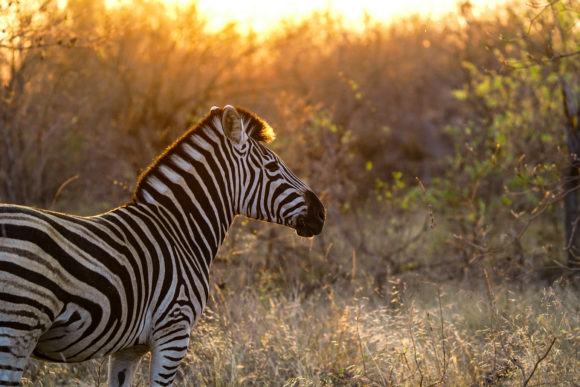There are always those classic age-old zebra stripe theories that have existed since I can remember.
One of the most common debates in the bush is whether a zebra is black with white stripes or white with black stripes. This debate will go on for ages, with everybody giving their two cents on why they believe one or the other.
Regardless of which one is true (but if you keep reading, you’ll find out!), here are some other zebra stripe theories and truths for you to ponder over.

Zebra Stripe Theories
1. It acts as camouflage
Can the stripes on a zebra help them avoid becoming a predator’s meal? There are a few issues with this idea, and experiments show that zebras stand out clearly to the human eye even when among vegetation or in fading light. If the stripes are for camouflage, it’s not really working! Another theory is that zebras try to confuse predators when fleeing from danger, thanks to the stripes having a dazzling effect. However, they don’t really behave in an unusual way, which busts this theory too.
To make matters worse, lions and spotted hyenas have much poorer eyesight than humans. As a result, these predators can only notice stripes on the zebras when they are very close, and then they can hear and smell them anyway.
Zebras are also most definitely a preferred food source for lions, and they frequently hunt them. In fact, lions kill more than expected due to the high density and availability of zebras in the wild. Therefore, this can cause a lot of doubt on whether stripes act as an anti-predator defence.
2. It helps them recognise each other

There’s another theory that perhaps stripes help zebras recognise and engage with each other. Every zebra has a unique stripe pattern but could it be useful for various individuals to recognise one another? This is also unlikely as different coloured domestic horses can recognise each other through sight and sound.
3. It protects them against the hot African sun
What about defending them against the hot African sun? It’s thought that the black stripes could absorb radiation when the zebra is cold and white stripes reflect it when the zebra is too hot. However, thermographic measurements of zebra, impala, buffalo and giraffe in the wild show that zebras are no cooler than any other species living within the African bush.
4. Stripes deter flies and insects

The last idea out of all of them also sounds the craziest of them all. How on earth can their stripes prevent flies and insects from sitting on them?
Well, data has shown that the intensity of striping prevents biting and fly annoyance. Wild equids indigenous to areas where irritation from horseflies is prolonged over the year are those most likely to have marked striping patterns.
Flies have much poorer vision than humans. And although horseflies approached as many zebras as they did horses, zebras experience far fewer landings. When around horses, flies seem to hover, spiral and turn before touching down again and again. However, around zebras, flies either fly right past them or make a single quick landing before flying off again.
The idea is that stripes set up an optical illusion that disrupts the expected pattern of movement the fly experiences as it approaches the zebra, preventing it from landing and staying put. Another idea is that flies don’t see the zebra as a solid entity but a series of thin black objects. Only when very close do they realise that they’re going to hit a solid body and instead veer off.
Last but not least: are zebras black with white stripes or white with black stripes?
And finally, are zebras black with white stripes or white with black stripes? The long-awaited answer is that zebras are, in fact, black with white stripes, and here’s why!
A zebra’s fur grows out of follicles containing melanocytes, occurring in all animals. These follicles are responsible for the generation of pigments which gives all skin and hair colour. Melanocyte cells produce melanin, the primary visible pigment.
In zebras, the chemical messages decide which parts of the fur receive pigments and which parts don’t. This results in the production of a black and white pattern seen on the zebra. It’s important to remember with zebras that the white fur produced is due to the absence of melanin, as white is not a pigment on its own. White stripes only occur because the black pigment is denied, and therefore it’s understood that black is the zebra’s default colour.
I think it’s now safe to say that zebras are black with white stripes! However, what we know for sure is that these patterns are unique, and you have to see them to believe that these animals can exist and thrive out here in this unforgiving environment.

Come Visit Our Zebras at Silvan Safari
Come see our spectacular zebras at Silvan Safari. Mention a few of the truths to these zebra stripe theories on safari, and you’ll be the most clued up one on the trip!
Let’s start planning your luxury Silvan Safari today.
Read more of our Silvan Safari Blogs
- Step into Each of the Suites at Silvan Safari
- Change of Seasons and What to Expect
- Meet Some of Our Wildlife Guests
- What Makes Silvan So Special?